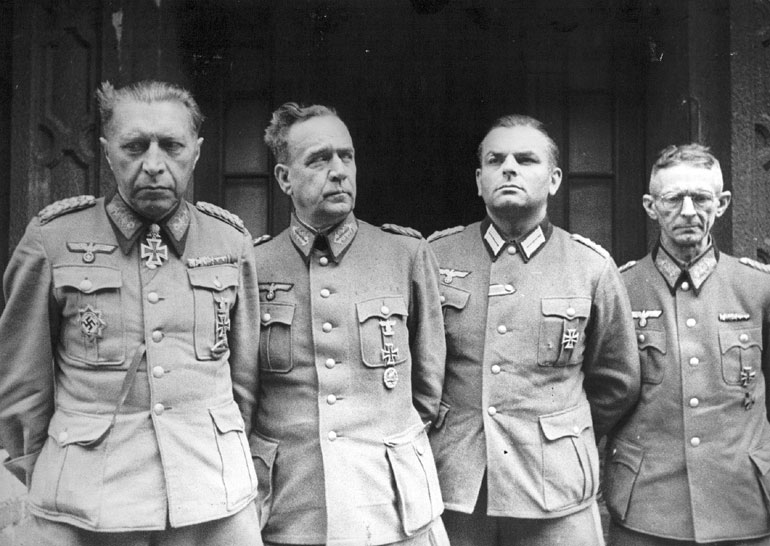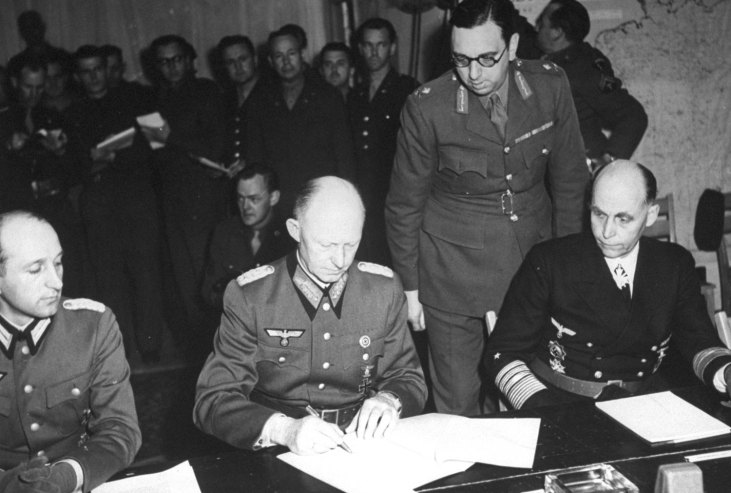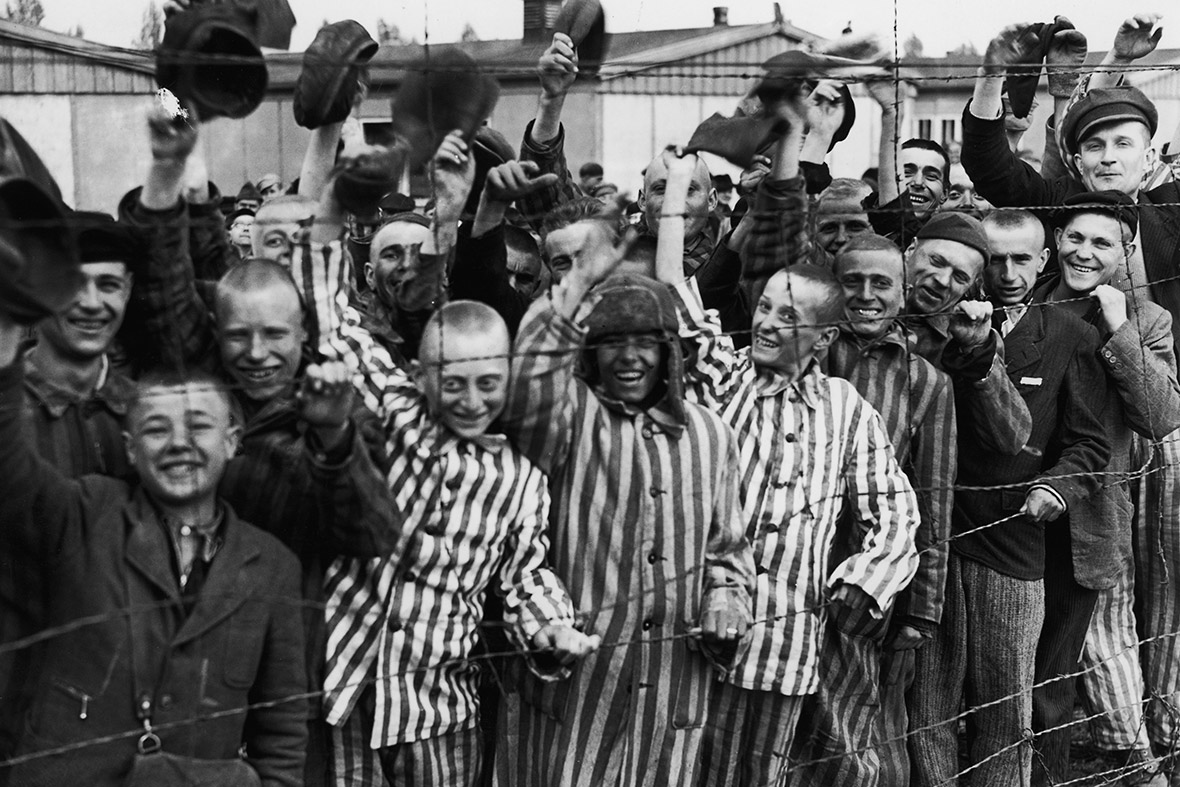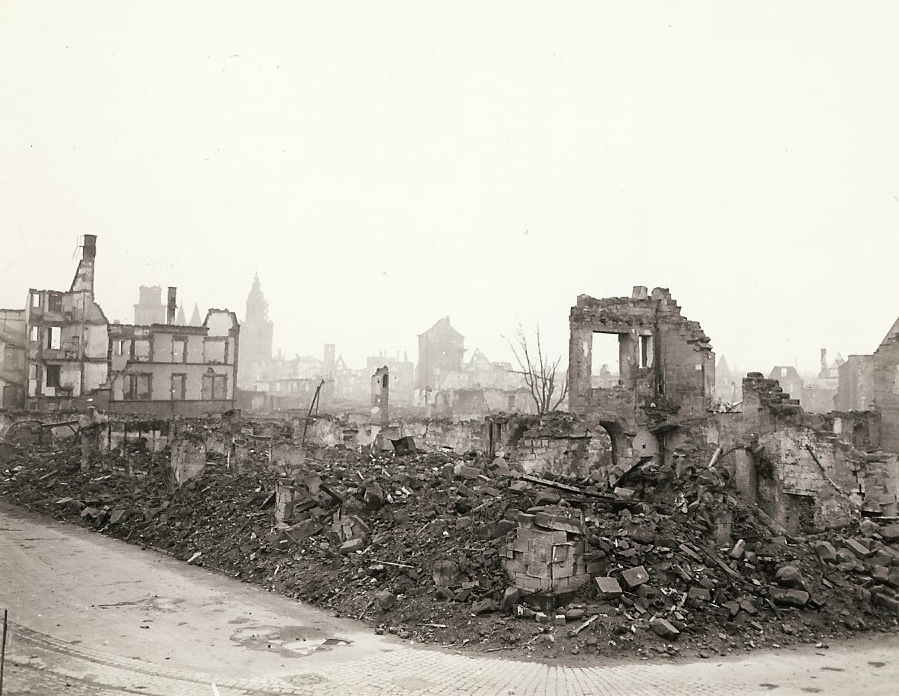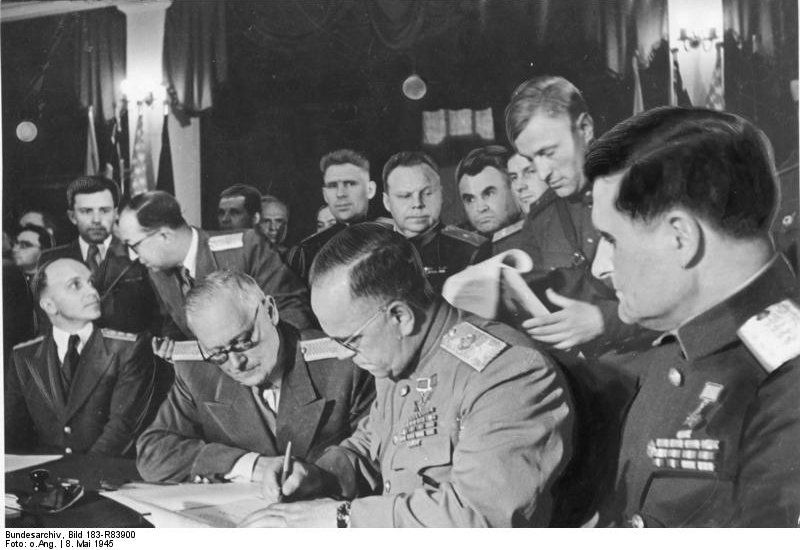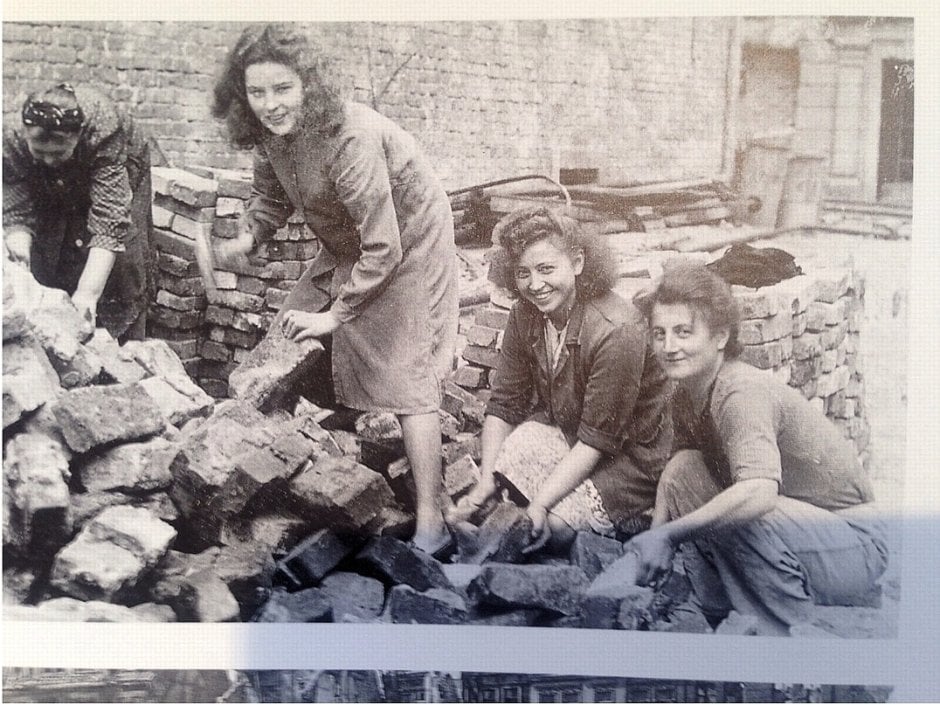The Potsdam Conference in August 1945 created arrangements and outline for new government for the post-war Germany as well as war reparations and resettlement. All German annexations in Europe after 1937, such as the Sudetenland, were reversed, and in addition Germany's eastern border was shifted westwards to the Oder-Neisse line, effectively reducing Germany in size by approximately 25% compared to her 1937 border. The territories east of the new border comprised East Prussia, Silesia, West Prussia, and two thirds of Pomerania. These areas were mainly agricultural, with the exception of Upper Silesia which was the second largest centre of German heavy industry.
Virtually all Germans in Central Europe were subsequently over a period of several years expelled , affecting about seventeen million ethnic Germans. Most casualty estimates of this expulsion range between 1 to 2 Million dead. The French, US and British occupation zones later became West Germany , while the Soviet zone became the communist East Germany .
The initial repressive occupation policy in Germany by the Western Allies was reversed after a few years when the Cold War made the Germans important as allies against communism. East Germany recovered at a slower pace under Communism until 1990, due to reparations paid to the Soviet Union and the effects of the centrally planned economy. The persecution of minorities and "undesirables" continued both in Germany and the occupied countries. From 1941 onward, Jews were required to wear a yellow badge in public and most were transferred to ghettos, where they remained isolated from the rest of the population. In January 1942, at the Wannsee Conference and under the supervision of Reinhard Heydrich, a plan for the " Final Solution of the Jewish Question" (Endlösung der Judenfrage) in Europe was hatched. From then until the end of the war some six million Jews and many others, including homosexuals, Slavs, and political prisoners, were systematically killed.
The Japanese military, deeply engaged in the seemingly endless war it had started against China in mid-1937, badly needed oil and other raw materials. Commercial access to these was gradually curtailed as the conquests continued. From then on, as the desperate Japanese schemed to seize the oil and mineral-rich East Indies and Southeast Asia, a Pacific war was virtually inevitable.
During this period, the heavy influence of business cycles on the immigration and remigration of foreign labor was apparent. When the next boom period started in 1968, the migration balance again became positive as a result of further labor recruitment. Every day some five hundred to a thousand new guest workers were recruited, bringing the surplus of foreign immigrants to 387,000 a year. Sometimes trains and planes had to be chartered in order to bring enough additional workers into the country. The foreign population grew from 1.9 to 4.0 million, and the number of foreign workers and employees increased from 1.1 million to its historical peak of 2.6 million .
In 2015, a total of 2.14 million people immigrated to Germany, while approximately 998,000 people left the country during the same period. Over the past few years, the majority of immigrants arrived from European countries, especially from EU member states. Due to the large number of asylum seekers from countries outside of Europe, the share of citizens of the European Union among all immigrants was only around 40 percent. Syria was the main country of origin of new immigrants, ahead of Romania and Poland (cf. Fig. 2).
Starting in the late 1960s, the rotational model, well accepted at first, began to lose ground. Many labor migrants were not able to save as much money within one or two years as they had hoped. West German employers, forced constantly to revolve their foreign staff, no longer wanted to keep recruiting and training new workers just because the work and residence permits of those recruited earlier had expired.
The governments of some countries of origin began to voice criticisms, as did German trade unions, employers, and other groups. The West German government reacted by easing restrictions on the renewal of residence permits. Beginning in 1971 labor migrants who had worked in Germany for at least five years could claim special work permits valid for another five years. A growing number of spouses and children of foreign labor migrants moved to Germany. The ability of the German authorities to regulate immigration according to the demands of the labor market was thus strongly reduced.
The first phase of immigration at the end of World War II and immediately thereafter consisted mainly of refugees and expellees from the Eastern parts of the German Reich as well as from Poland, Czechoslovakia, Hungary, and Yugoslavia. The census of 10 October 1946, registered 5.9 million refugees and expellees in the British and U.S. zones and 3.6 million in the Soviet zone . The census of 13 March 1950, counted 7.9 million refugees and expellees living in West Germany . By the beginning of the 1950s approximately 12 million ethnic Germans from the former eastern parts of the Reich and from East Central Europe had emigrated to the FRG, the GDR, and Austria (Benz 1985; Stanek 1985).
When comparing the number and share of these immigrants in the GDR (3.6 million, i.e., 20 percent of total population) and the FRG (7.9 million, or 16 percent of the total population), we see that the demographic impact was somewhat larger in the east. To a certain extent, the fact that this migration was a result of expulsion, forced resettlement, and ethnic cleansing might explain the greater degree to which these migrants were accepted within East and West German society at that time . In the past, some push and pull factors existed for GDR citizens, ethnic Germans, and foreigners alike. However, the dynamics of immigration and emigration have to be explained separately for each of the different groups. GDR citizens and ethnic Germans coming to West Germany from Eastern Europe and Central Asia hardly ever thought of returning some day to their countries of origin, whereas some of the foreign laborers and asylum seekers did.
The chances of being successfully integrated into Germany's economic and social life also differed among these groups. 1945 to 1949 Mainly immigration of ethnic German refugees and expellees and remigration of non-German forced labor, prisoners of war, and survivors of the concentration camps of Nazi Germany. During the 1950s and 1960s, the young Federal Republic of Germany experienced an economic boom which went hand in hand with an enormous expansion of the labor market. Since the domestic workforce was no longer sufficient to cover demand, Germany entered into the first agreements for the recruitment of workers with Italy in 1955, and with Greece and Spain in 1960. Treaties with Turkey , Morocco , Portugal , Tunisia and Yugoslavia followed suit.
The migrant workers generally assumed unskilled labor and positions with minimal training requirements in industrial production with high physical stress, health burdens and wage conditions that many locals were not willing to accept . The recruitment of so-called "guest workers" was terminated during the oil crisis and due to increasing unemployment in 1973. Yet, this decision can also be ascribed to the increased permanent settlement of foreign workers in the self-proclaimed 'non-immigrant country' of Germany.
From the late 1950s until the stop in labor recruitment in 1973, approximately 14 million foreign workers came to Germany, of whom 11 million only stayed in the country temporarily and eventually returned to their home countries. Because of this development, the number of foreign workers decreased after the end of the recruitment period – from 2.6 million in 1973 to 1.6 million in 1989 – but the foreign population grew from 3.97 million to 4.9 million during the same period. The birth rate in many of the new member states has been low since political transformation at the beginning of the 1990s. As in Western Europe, a decreasing number of people will be of working age. Therefore, it seems that Germany will not be "swamped" by migrants from the new member states – though at the same time, this means those migrants may not be available to solve the demographic problems of Germany's aging population. The initial closure of the labor market to citizens of the new EU states and non-EU citizens, which will be changed little by the immigration law, is likely to channel them to traditional immigration countries such as the United States, Canada, or Australia.
In addition to the murder of European Jews, the Nazi government was responsible for the persecution of several other groups of people. Poles, Sinti, and Roma were viewed as racially inferior to the Aryans and were subjected to death and labor camps. They persecuted church leaders and Jehovah's Witnesses who refused to salute Hitler, served in the German army, or opposed Nazism in general.
Homosexuals, specifically men, were viewed as a hindrance to the preservation of the German nation and were therefore subjected to concentration camps. All foreign laborers were subjected to constant surveillance by the racist bureaucratic repression and policing apparatus of the Wehrmacht, labor office, Werkschutz , SS and Gestapo. They were squeezed into drafty barracks or overcrowded guesthouses and banquet halls. Supplied with completely inadequate rations in the camp and factory canteens and without food stamps to buy food with their meager wage, they were constantly suffering from hunger. They were even more defenseless than the German population in the face of air raids since most of them had no access to shelters.
Despite repression, denunciation, loss of orientation and the devastating living conditions in their occupied and plundered homeland, forced laborers repeatedly tried to flee; there were also resistance and sabotage attempts. Without legal means of appeal, even the mere suspicion of these offenses could result, in extreme cases, in deportation to concentration camps or even execution. In cases of "idling" or refusal to work, there was the threat of the infamous "work education camps".
The foreign population also included 1,050,000 people from the former Yugoslavia, 600,000 Italians, and 355,000 Greeks. About 25 percent of the total foreign population was from countries of the European Union, and an additional 55 percent came from other western and eastern European countries like Norway, Switzerland, Russia, Ukraine, and Hungary. Overall, 80 percent of the foreigners came from Europe, while almost 12 percent were Asians.
The number of foreigners now amounted to four million, and their share of the population reached 6.7 percent of Germany's total population. Some 2.6 million foreigners were employed — a level which has not been seen since then. By 1973, the most important country of origin was no longer Italy, but rather Turkey, which accounted for 23 percent of all foreigners. Other countries of origin included Yugoslavia , Italy , Greece , and Spain . Many business, labor, and religious organizations welcomed the 2002 effort to pass an immigration law, but the deadlock that followed until recently could be interpreted as ongoing resistance to formally opening Germany as a country of immigration. This is despite the fact that the country's foreign population has exceeded seven million people for each of the last 10 years, not counting those migrants who have acquired German citizenship.
Meanwhile, other factors, such as the accession to the European Union of 10 new countries in May 2004, promise new challenges for Northern Europe's economic powerhouse. Japan had ruled the Korean peninsula for 35 years, until the end of World War II. At that time, Allied leaders decided to temporarily occupy the country until elections could be held and a government established. The planned elections did not take place, as the Soviet Union established a communist state in North Korea, and the U.S. set up a pro-western state in South Korea—each claiming to be sovereign over the entire peninsula. This standoff led to the Korean War in 1950, which ended in 1953 with the signing of an armistice, but to this day, the two countries are still technically at war with each other.
The living conditions of the people required to perform forced labor in Germany or in the occupied territories varied from nation to nation and according to legal status and gender. People from the Soviet Union (in the jargon of the Nazis, so-called "OST-Arbeiter" or Eastern workers) and from Poland were defenselessly subjected to the discriminatory special orders of the arbitrary nature of the Gestapo and other policing departments. Often, they were only allowed to leave their camps to work and were required to wear a badge with the corresponding designation ("OST", "P") on their clothes at all times. This racial hierarchy of the Nazi regime was supported by the widespread anti-Slavism among the German people, which led to additional insults, denunciations and mistreatment.
As alleged traitors, the "military internees" abducted and taken to Germany after Italy's surrender in the autumn of 1943 also were miserably treated. Life for the skilled workers and engineers attributed to Western Europe or the "Nordic race" were more bearable, but nevertheless characterized by deprivation and humiliation. What was endured by the concentration camp prisoners, particularly Jews, Sinti and Roma targeted for "Vernichtung durch Arbeit" was slave labor at its worst. At the height of the so-called "Ausländereinsatz" in August 1944, six million civilians were forced to perform forced labor in the German Reich, most of them from Poland and the Soviet Union. Over one third were women, some of whom were abducted together with their children or gave birth to their children in the camps. In 1944, nearly two million prisoners of war were exploited to work in the German economy.
From 1943, German industry also increasingly used concentration camp detainees as a source of forced labor. A new wave of immigration set in after 1987, spurred by a rise in the number of applicants for asylum , the fall of the Iron Curtain, war and ethnic cleansing in former Yugoslavia, and the mounting pressure on the Kurds in southeastern Turkey. Ethnic conflicts and bloodshed in former Yugoslavia and southeastern Turkey increased not only the number of asylum seekers but regular migration as well.
Many foreign workers originating from these regions chose to bring remaining family members to Germany. The same fate was shared by tens of thousands of Eastern European Jews who were looking for protection from pogroms and anti-Semitic developments in many parts of Eastern Central, South Eastern and Eastern Europe. With the National Socialists' rise to power, Germany yet again – as before World War I – became an asylum-opposed state. This affected political opponents of the regime, those who the regime deemed to be opponents and especially all those who were being increasingly dehumanized and persecuted due to the racist ideology of National Socialism. Primarily, it was the Jews of whom about 280,000 to 330,000 were able to flee the Reich from 1930 to 1940.
Approximately 195,000 German Jews, who were not able to escape, were murdered by the end of the war. Only about 15,000 to 20,000 survived the camps or remained hidden in the Reich. In 2000, the government appointed a commission to work out proposals for an immigration and integration policy. In light of such developments, the commission argued for initiating a controlled immigration program for foreigners with favorable characteristics for integration into both the labor market and society. They proposed the implementation of a point system as a tool for selecting 20,000 immigrants per year based on criteria of education, age, and language skills. In the event of urgent labor shortages, another 20,000 immigrants should be let into the country on a five-year basis.
By that time, the authorities will have gathered some experience, and changes and improvements can be made. Despite Germany's long history of recruiting foreign workers, the turn toward a more organized and focused recruitment of highly skilled labor in 2000 marks a watershed. This change, coupled with a demographic shift toward a more elderly population and a continuing low total fertility rate (now at 1.4) led to a broader discussion about a formal immigration policy that takes these factors into account. In 2001, the government also counted an estimated 1.1 million refugees in the legal foreign population of 7.3 million. This included 301,000 recognized asylum seekers and their family members, along with another 164,000 refugees whose applications for asylum were still being processed.
Another 173,000 of the 1.1 million refugees are Jews from the former Soviet Union who have come to Germany since reunification. This last group is not required to prove that they, as individuals, have been persecuted in order to immigrate to Germany. On the one hand, the German government hoped to capture some of the migration potential in the region and to channel it into labor-hungry sectors, while also advancing long-term foreign and economic policy objectives in the region. On the other hand, the remittances and experiences of the returning workers were expected to help the fledgling economies of the sending countries. Guest workers in several categories, such as trainees, contract, and seasonal work, received temporary residence and work permits ranging from three months for seasonal workers to a maximum of two years for contract workers.
Contract workers generally came to work on a larger project directed by their firm, e.g., construction projects. Of these, 45,000 were for contract workers, about 50 percent of whom came from Poland. Some 298,000 permits were issued for seasonal workers, 85 percent of them Polish citizens. Since the 1990s, analysts have pointed to Germany's ongoing need for immigrants to bolster economic development and maintain a dynamic workforce, given the rapid aging of the country's population. However, a process of policy review that began in 2001 with a government commission's report on immigration and integration policy only recently overcame legislative gridlock. An immigration law based on the report's recommendations, prepared by the governing Social Democrat and Green coalition, passed both houses of the German Parliament and was subsequently signed by President Johannes Rau in March 2002.
However, it was procedurally contested by the country's conservative coalition, which successfully filed a lawsuit with the Federal Court. Since then, government and opposition negotiators have been trying to reach a compromise. Only recently, after difficult, long-running negotiations, have the government and opposition agreed on an immigration law, which was passed by the lower and upper chambers in June/July 2004.
The law will take effect on January 1, 2005, setting the stage for how Germany will deal with labor migration, newcomers, and resident migrants in the years to come. The city gradually built its position as an important financial center, luring both national and foreign investors. Today's Warsaw has a population of 1.7 million people and this dynamic growth is expected to continue. The city does not cease to renew itself, becoming ever more beautiful, modern and functional. Warsaw is also home to an ever-growing labor market with a growing number of foreign investors settling here.
New luxurious housing and office complexes designed by foreign architects are added to the landscape on a frequent basis. During the Second World War, one of the major topics under discussion at conferences of the Allied leadership was how to deal with Germany after the war. President Franklin Roosevelt and Soviet leader Joseph Stalin in 1943, the two countries agreed that after the war Germany would be divided and occupied jointly. At the final wartime conference between these two men at Yalta in 1945, the two powers agreed to shift the eastern border of Germany to the West, enlarging western Poland as compensation for the eastern sections of that country annexed by the Soviet Union. They also determined that the occupation would divide Germany into sections, with each Allied power taking responsibility for one section, although they would be governed as a single economic unit in anticipation of their eventual reunification.






